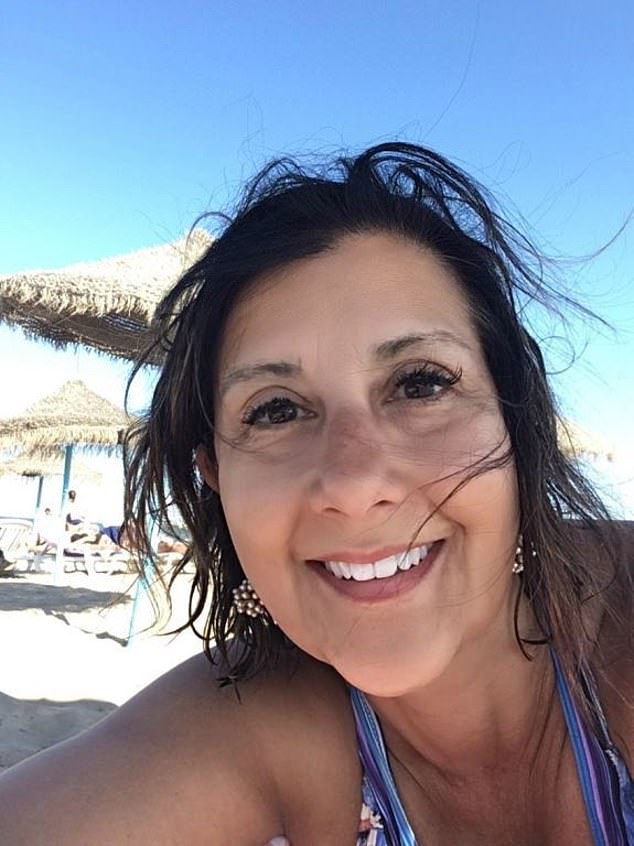Esther Shoebridge is not the kind of person to bother her GP without a reason: the 59-year-old gym-goer, long-distance walker and former optician from Beverley, East Yorkshire, prides herself on being healthy and independent.
But after experiencing severe pain in her neck that didn’t subside in the fall of 2020, Esther went to see a doctor, who reassured her that it wasn’t anything serious. The advice was to go home, take some painkillers, and rest until the discomfort subsided.
As the pain had not subsided I went back to my GP a few weeks later and he gave me the same advice – painkillers and rest.
In fact, it would be another five months before Esther learned the shocking truth: the root cause of her suffering was a broken neck.

Esther Shoebridge was told her broken neck was caused by myeloma, an incurable blood cancer that means even a minor fall or slip could cause serious injury.
But there was more bad news: doctors at Queen’s Medical Centre in Nottingham told her the fracture was caused by an incurable blood cancer that would almost certainly kill her within five years.
The tumor, called myeloma, had spread throughout her body, burning numerous holes in her bones, skull and spine, putting her at serious risk of further damage from even the slightest slip or fall.
And, as she later realized, if her neck problem had been taken seriously earlier, she could have received treatment to prevent bone damage and likely enjoyed a decent quality of life for a longer period of time.
“This was during the height of strict Covid-19 restrictions,” Esther says, “so my husband Philip wasn’t allowed to be with me when we heard the shocking news.”
“I was in tears. I didn’t want to leave Philip, my daughter Grace and my four beautiful grandchildren behind. There was so much I still wanted to do.”
“The doctor who broke the news to me said, ‘I don’t think you’ve ever heard of myeloma.'”
“But I told him I was well aware of that. I had just spent a year helping a close friend care for his mother, who died from the disease.”



One of Esther’s first symptoms was extreme thirst, and she was drinking up to four litres of water each day.



Experts say that if Esther had been diagnosed earlier, the debilitating injuries resulting from myeloma could have been prevented.
“But I never for a second thought it was mine. I felt I was too young to have something like that.”
Myeloma affects around 4,500 people in the UK, mainly people over 65. Bone marrow is the sponge-like material inside the bones where blood cells mature and myeloma occurs when DNA damage occurs.
This damage causes abnormal cells to grow and release harmful proteins that make bones more likely to break. Symptoms range from bone pain and fatigue to kidney damage and nerve pain.
In Esther’s case, she later realized, one of the first signs was extreme thirst, because the myeloma had also affected her kidneys, making them unable to remove excess calcium from the bloodstream. Her body then dramatically increased its water intake in an attempt to flush it out.
Esther was drinking up to four litres of water a day.
“At first I felt strangely weak and dizzy, couldn’t walk as far as I usually do or go to the gym,” she says. “Then I felt extremely thirsty and my weight started to drop from nine stone to seven stone. I also had frequent insomnia and infections.”
It got to the point where Esther had to hold her head up to stop it from falling.



Esther’s first two rounds of chemotherapy were unsuccessful, but by the third attempt her cancer has stabilized.
“I bought a neck brace because I thought I might have hurt my neck. It felt awful just remembering that I had been battling these symptoms for months while cancer was eating away at my body.”
Experts say that if Esther had been diagnosed earlier, the debilitating disabilities resulting from myeloma might have been prevented, though the cancer itself would not have been curable. Treatments such as chemotherapy can slow the disease’s progression and limit the damage it causes to bone.
“Myeloma robs bone of strength so a delay of five months would have done more damage in Esther’s case,” says Professor Graham Jackson, a myeloma specialist at Newcastle Hospitals NHS Foundation Trust. “If diagnosed early, myeloma can mean survival times of up to 15 years.”
Professor Graham added: “The longer it goes untreated, the greater the chance of fracture or broken bones. However, one in four patients wait 10 months from the onset of symptoms until they are diagnosed – the longest for any cancer.”
Chemotherapy is not a cure, but it can reduce the number of myeloma cells.
In Esther’s case, the first two treatments were unsuccessful, but after the third treatment her cancer has stabilized.
Promising treatments are in development, such as CAR-T therapy (a type of immunotherapy that helps the body’s defense system target cancer), but these are not yet approved for use in myeloma.
Esther says: “I’m not going to let this defeat me. In August 2022 I walked four miles a day for five days and raised over £2,500 for the British Myeloma Society – not bad for someone who broke their neck. I’m in the fittest shape I’ve been in for years and this summer I’ll be flying to the US to visit my daughter Grace and grandchildren in Florida.”

